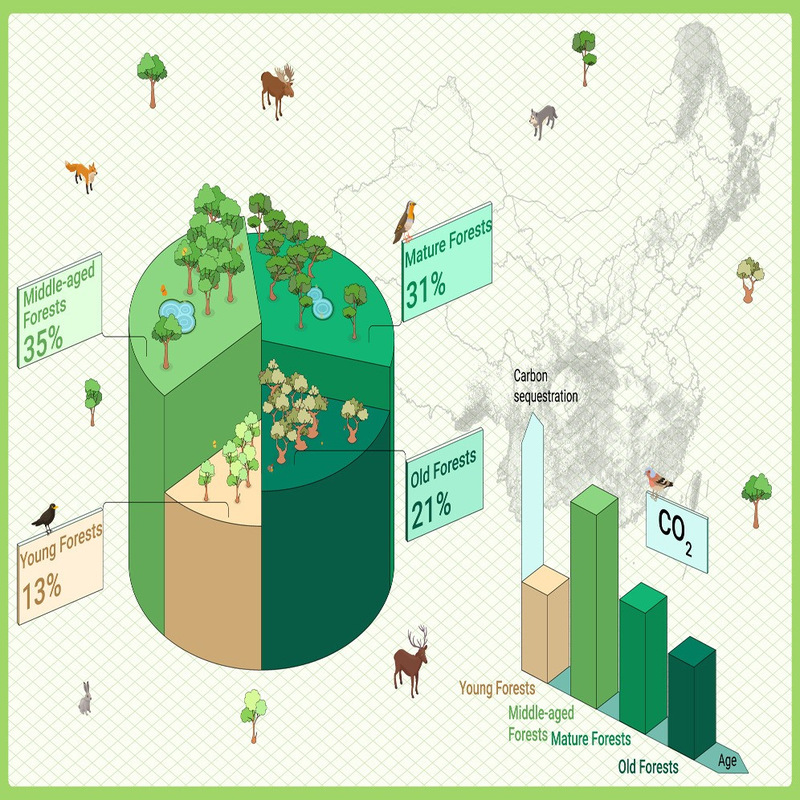Forest carbon sinks are expected to increase exponentially to achieve carbon neutrality. Many studies have predicted a 22%-67% increase in future forest carbon sinks in China for natural and anthropogenic reasons. However, these predictions may be overly optimistic as the effects of forest age on carbon sinks have not been taken into consideration in these studies. Forest carbon sink potential is closely related to net primary productivity (NPP), which increases rapidly at young ages, peaks at middle ages, and then decreases at old ages. The decrease in NPP in aging forests is mainly driven by the reduction in gross primary productivity (GPP) and autotrophic respiration (Ra) as the forests age, where GPP declines faster compared with Ra. China has conducted intensive afforestation and reforestation programs since the 1960s, resulting in an increase in forest cover from 14% to 23%. And most of the forests are currently in the young-and middle-aged categories with high carbon uptake capacity. High carbon sinks are thus likely to prevail in the near future in China given the absence of large-scale deforestation. However, there is a high risk that the carbon sink will decrease with natural forest aging.
The vast majority of China’s forests grow in mountainous areas, and forest stands are small (102-1002 m2) due to topographic variation and anthropogenic disturbances. However, currently, the spatial resolution of forest age products covering all of China is 1000 meters, which is far beyond the stand scale and not adequate for the quantitative analysis of China’s forest age structure and the prediction of how future forest carbon sinks change. For example, a 10-year-old forest and a 60-year-old forest could both have low growth rates, but when they are averaged to become a 35-year-old forest, the growth rate could double. Therefore, mapping forest age commensurate with forest stands is required to improve forest carbon sink prediction. Meanwhile, we also lack forest growth curves for different forest types and regions in China, which makes it difficult to predict how forest age will affect China’s carbon sink.
To address the above problems, Academician Chen Jingming’s team first generated a 30-meter-resolution forest age map in 2019 based on high-resolution (30 m) satellite images over China’s landmass as well as forest disturbance monitoring and machine learning, and then derived forest growth curves for different forest types and regions using field survey data, satellite data and forest inventory data in 3,121 plots. Last, the team predicted and evaluated the potential in increasing sink and changes in reducing sink from 2022 to 2100 based on the current forest age and the derived forest growth curves and the historical changes in China’s forest NPP downscaled at the 30 m resolution from 2000 to 2021. The results show that because of the current forest age structure, China’s forests will maintain high growth rates for about 15 years. However, as the forests grow older, their NPP will decline by 8%-17% from 2060 to 2100, indicating weakened carbon sinks in China in the near future. The weakening of forest carbon sinks can be potentially mitigated by optimizing forest age structure through selective logging and implementing new or improved afforestation. The finding is important not only for the local and global carbon cycle and climate projections but also for developing forest management strategies to enhance land sinks.
The results, titled “China’s current forest age structure will lead to weakened carbon sinks in the near future”, were published in the journal The Innovation. FNU is the first completion unit of the paper, with Shang Rong, Associate Professor of the School of Geographical Sciences and the School of Carbon Neutrality Future Technology of FNU, as the first author, and Professor Chen Jingming as the corresponding author. The work was conducted in collaboration with the Massachusetts Institute of Technology, the University of Hong Kong, and the Institute of Geographic Sciences and Natural Resources of the Chinese Academy of Sciences, and supported by the Youth Project of the National Natural Science Foundation of China, the Youth Innovation Project of the Natural Science Foundation of Fujian Province, Fujian Forestry Science and Technology Key Project, and the Open Fund Project of the Academy of Carbon Neutrality of FNU.
Paper link: https://doi.org/10.1016/j.xinn.2023.100515

(Translated by Wang Ye/ Reviewed by Xie Xiujuan)
